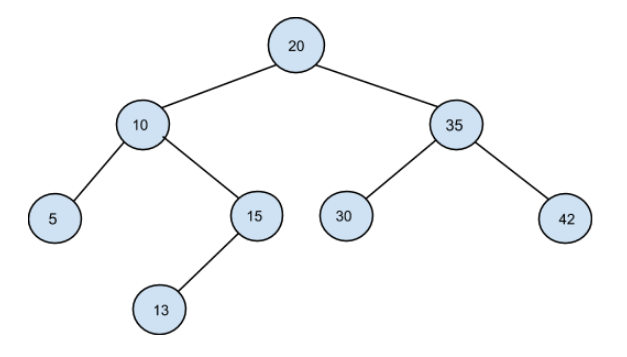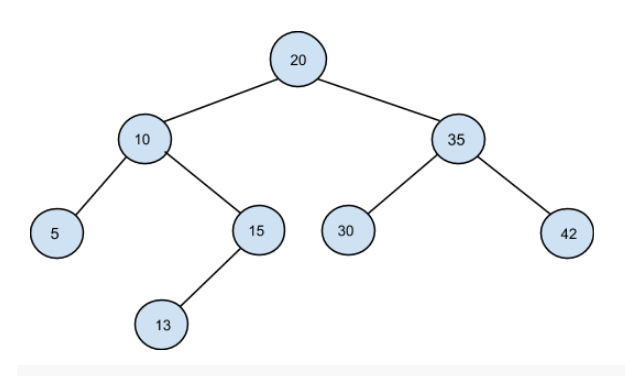Given a Binary Search Tree, where exactly two nodes of the same tree were swapped by mistake. The task is to restore or fix the BST, without changing its structure.
A binary search tree (BST), also called an ordered or sorted binary tree, is a rooted binary tree whose internal nodes each store a key greater than all the keys in the node's left subtree and less than those in its right subtree.
Note:
Given BST will not contain duplicates.
A Binary Search Tree (BST) whose 2 nodes have been swapped is shown below.

After swapping the incorrect nodes:

Follow Up
Can you do this without using any extra space?
Input Format
The first line of input contains an integer T, the number of test cases.
The first line of every test case contains elements in the level order form. The input consists of values of nodes separated by a single space in a single line. In case a node is null, we take -1 on its place.
For example, the input for the tree depicted in the above image would be: { 20 30 35 5 15 10 42 -1 -1 13 -1 -1 -1 -1 -1 -1 -1 }
Explanation :
Level 1 :
The root node of the tree is 20
Level 2 :
Left child of 20 = 30
Right child of 20 = 35
Level 3 :
Left child of 30 = 5
Right child of 30 = 15
Left child of 35 = 10
Right child of 35 = 42
Level 4 :
Left child of 5 = null (-1)
Right child of 5 = null (-1)
Left child of 15 = 13
Right child of 15 = null (-1)
Left child of 30 = null (-1)
Right child of 30 = null (-1)
Left child of 42 = null (-1)
Right child of 42 = null (-1)
Level 5:
Left child of 13 = null (-1)
Right child of 13 = null (-1)
The first not-null node (of the previous level) is treated as the parent of the first two nodes of the current level. The second not-null node (of the previous level) is treated as the parent node for the next two nodes of the current level and so on.
The input ends when all nodes at the last level are null (-1).
Note :
The above format was just to provide clarity on how the input is formed for a given tree.
The sequence will be put together in a single line separated by a single space. Hence, for the above-depicted tree, the level order will be given as:
20 30 35 5 15 10 42 -1 -1 13 -1 -1 -1 -1 -1 -1 -1
Output Format:
For every test case, print the level order traversal of the restored tree.
The output of each test case is printed in a separate line.
Note:
You don’t have to print anything, it has already been taken care of. Just implement the function.
Constraints:
1 <= T <= 100
1 <= N <= 10^3
0 <= data <= 10^9
Where ‘data’ denotes the value of the nodes in the given tree.
Time limit: 1 second
Recursion can be used here. Maintain two pointers, first and second to find the 2 nodes that violate the order. At last, change the values of the two nodes by their value.
PseudoCode :
correctBST(Node...read more
The steps are as follows:
- Maintain an array, say ‘INORDERTRAVERSAL’, and store the inorder traversal of the given BST in this array.
- Now sort the ‘INORDERTRAVERSAL’ array.
- After so...read more
The steps are as follows:
- Maintain an array, say ‘INORDERTRAVERSAL’, and store the inorder traversal of the given BST in this array.
- Traverse the array from left to right and ...read more
The idea is to visit the tree in an in-order fashion and search for two swapped nodes. After finding the incorrect nodes, we will swap their data.
The steps are as follows:
1. We will maint...read more
The idea is to visit the tree in an inorder fashion and search for two swapped nodes. After finding the incorrect nodes, we will swap their data.
This approach is very similar to the previous approach but here we will not use recursion or any extra data structure to store the nodes. We will be using Morris Traversal.
In inorder traversal, first, we visit the left subtree, then the root node, and the right subtree. As we are not using recursion or stack, we will be creating a back-link between a node and its inorder successor.
Morris traversal is similar to recursive/iterative traversal, but we need to modify the tree structure during the traversal. Before visiting the left tree of a root, we will build a back-link between the rightmost node in the left tree and the root. So, we can go back to the root node when we are done with the left tree. Then we locate the rightmost node in the left subtree again, cut the back-link, recover the tree structure and start visiting the right subtree.
For example: In the picture below, back-links between (4-2) and (5-1) are created.
- When we are done visiting 4, we can go to the next node of 4 in its inorder traversal (in order successor) using this back-link.
- When we are done visiting 5, we can go to the next node of 5 in its inorder traversal (in order successor) using this back-link.
For a detailed explanation of Morris's traversal, click here.
Note: For a valid BST, the value of the previous node should always be smaller than the value of the current node in the inorder traversal.
The steps are as follows:
1. Initialise a current node ‘CURR’ by the root node.
2. Maintain a ‘PREV’ node to keep track of the previous node of the current node ‘CURR’.
3. We will also maintain ‘FIRST’ and ‘SECOND’ nodes to store the incorrect nodes.
4. Initialise ‘PREV’, ‘FIRST’, and ‘SECOND’ by NULL.
5. While ‘CURR’ is not NULL:
- We check if ‘CURR’ has a left child.
- If it does not have a left child, we check if the ‘PREV’ node and the ‘CURR’ node form an incorrect pair. When the value of the ‘PREV’ node is greater than the value of the ‘CURR’ node, they form an incorrect pair. Here, we have two cases :
- If it is the first time we found an incorrect pair, the ‘PREV’ node must be the ‘FIRST’ incorrect node.
- If it is not the first time we found an incorrect pair, the ‘CURR’ node must be the ‘SECOND’ incorrect node. If it has a left child, we first create the back-link from the rightmost node in the left subtree and ‘CURR’. Then, we check if ‘CURR’ and ‘PREV’ form an incorrect pair. When the value of the ‘PREV’ node is greater than the value of the ‘CURR’ node, they form an incorrect pair. Here, we have two cases :
- If it is the first time we found an incorrect pair, the ‘PREV’ node must be the ‘FIRST’ incorrect node.
- If it is not the first time we found an incorrect pair, the ‘CURR’ node must be the ‘SECOND’ incorrect node.
- Keep updating the ‘prev’ and the ‘CURR’ node.
6. Now, we will swap the value of these ‘FIRST’ and the ‘SECOND’ nodes to recover the BST.
Space Complexity: O(1)Explanation:O(1)
Since we are not using any extra data structure. Only constant additional space is required. Thus the space complexity will be O(1).
Time Complexity: O(n)Explanation:O(N), where N is the number of nodes in the BST.
Since we are visiting each node in the tree exactly once which requires O(N) time. Thus the time complexity will be O(N).
Top Housing.com Software Engineer interview questions & answers
Popular interview questions of Software Engineer

Reviews
Interviews
Salaries
Users/Month